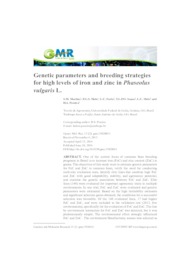Genetic parameters and breeding strategies for high levels of iron and zinc in Phaseolus vulgaris L.
Genetic parameters and breeding strategies for high levels of iron and zinc in Phaseolus vulgaris L.
Autoria: MARTINS, S. M.; MELO, P. G. S.; FARIA, L. C.; SOUZA, T. L. P. O.; MELO, L. C.; PEREIRA, H. S.
Resumo: One of the current focus of common bean breeding programs in Brazil is to increase iron (FeC) and zinc content (ZnC) in grains. The objectives of this study were to estimate genetic parameters for FeC and ZnC in common bean, verify the need for conducting multi-site evaluation tests, identify elite lines that combine high FeC and ZnC with good adaptability, stability, and agronomic potential, and examine the genetic association between FeC and ZnC. Elite lines (140) were evaluated for important agronomic traits in multiple environments. In one trial, FeC and ZnC were evaluated and genetic parameters were estimated. Based on the high heritability estimates and significant selection gains obtained, the conditions for a successful selection was favorable. Of the 140 evaluated lines, 17 had higher FeC and ZnC, and were included in the validation test (2013, five environments), specifically for the evaluation of FeC and ZnC. The line by environment interaction for FeC and ZnC was detected, but it was predominantly simple. The environmental effect strongly influenced FeC and ZnC. The environment Brasilia/rainy season was selected as the best evaluation site for preliminary tests for FeC and ZnC, because it resulted in similar conclusions as the mean of the five environments. The lines CNFP 15701 and CNFC 15865 had higher FeC and ZnC and were highly adaptable and stable, and are recommended for utilization in breeding programs. The lines CNFC 15833, CNFC 15703, and CNFP 15676 showed excellent combined agronomic and nutritional traits, and were selected for the development of biofortified cultivars. Additionally, the genetic association between FeC and ZnC was detected.
Ano de publicação: 2016
Tipo de publicação: Artigo de periódico
Unidade: Embrapa Arroz e Feijão
Palavras-chave: Beans, Biofortification, Elite lines, Feijão, Melhoramento genético vegetal, Phaseolus vulgaris, Plant breeding
Observações
1 - Por padrão são exibidas publicações dos últimos 20 anos. Para encontrar publicações mais antigas, configure o filtro ano de publicação, colocando o ano a partir do qual você deseja encontrar publicações. O filtro está na coluna da esquerda na busca acima.
2 - Para ler algumas publicações da Embrapa (apenas as que estão em formato ePub), é necessário ter, no celular ou computador, um desses softwares gratuitos. Sistemas Android: Google Play Livros; IOS: iBooks; Windows e Linux: software Calibre.
Acesse outras publicações
Acesse a Base de Dados da Pesquisa Agropecuária (BDPA) para consultar o acervo completo das bibliotecas da Embrapa.

